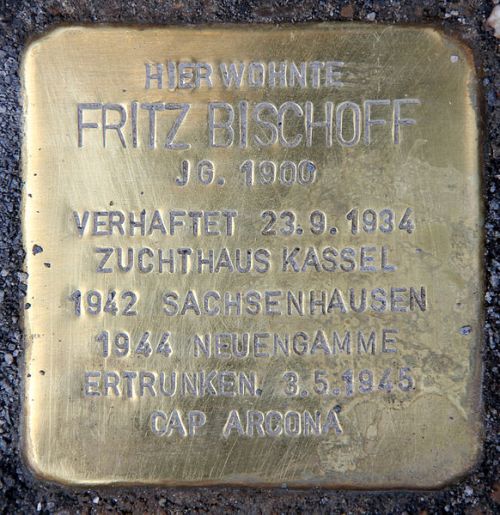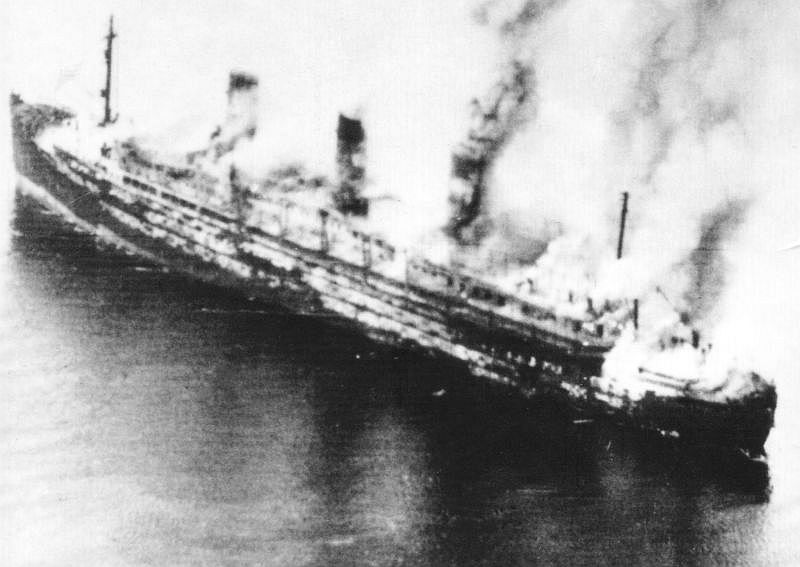Stumbling Stone Weisestraße 9
This small, brass, memorial plaque (Stolperstein, struikelsteen, or stumbling stone) commemorates:
* Fritz Bischoff, born 1900, arrested 23 September 1934, Kassel Penitentiary, 1942 Sachsenhausen, 1944 Neuengamme, drowned 3 May 1945, Cap Arcona.
Fritz Bischoff’s parents moved to this address during the First World War, and Fritz apparently lived there off and on. After his schooling, he completed an apprenticeship and then worked as a commercial clerk. He became politically active as a teenager, and in 1918/19 was a founding member of the KPD Kommunistische Partei Deutschlands). From 1922-1930 he worked for the Soviet Trade Agency in Berlin and in Hamburg. In 1923, he and Charlotte Wielepp married. She, also politically active, joined the KPD that year. The next year, their only child was born, daughter Renate. In 1933 Fritz Bischoff, then a district political leader of the KPD, organized resistance against the Nazis. In December, Charlotte and Renate emigrated to the USSR. Fritz was arrested in Heidelberg in 1934 and was kept in prison for 8 years. He was then taken to Sachsenhausen and Neuengamme for forced labor.
When the Nazis emptied the Neuengamme camp in April 1945 before the arrival of the Allies, thousands of prisoners were put on the Cap Arcona, a ship which became an overcrowded concentration camp with no food and no drinking water. The Cap Arcona and several other floating concentration camps were hidden in plain sight among other troop ships. With a goal of keeping the Germans from escaping by boat, the British bombed the ships in the harbor. Approximately 7,000 concentration camp prisoners died by fire or drowning, or were shot by Germans on the shore.
Four days later, the Germans signed an unconditional surrender of all German forces to the Allies.
For more information and photos about the Cap Arcona, please see Floating concentration camps in the Bay of Lübeck.
"Stolpersteine" is an art project for Europe by Gunter Demnig to commemorate victims of National Socialism (Nazism). Stolpersteine (stumbling stones) are small, 10x10cm brass plaques placed in the pavement in front of the last voluntary residence of (mostly Jewish) victims who were murdered by the Nazis. Each plaque is engraved with the victim’s name, date of birth, and place (mostly a concentration camp) and date of death. By doing this, Gunter Demnig gives an individual memorial to each victim. One stone, one name, one person. He cites the Talmud: "A human being is forgotten only when his or her name is forgotten."
Do you have more information about this location? Inform us!
Source
- Text: Fedor de Vries & Anne Palmer
- Photos: OTFW, Berlin
- Stolpersteine in Berlin: Fritz Bischoff
- Stolpersteine.eu
Related books
Nearby
Museum
- Luftschutzraum/Dokumentenbunker Tempelhof - Berlin
- Bezirksmuseum Friedrichshain-Kreuzberg - Berlin-Kreuzberg
- Jüdisches Museum Berlin (Jewish Museum Berlin) - Berlin
Point of interest
- Bullet Impacts Columbiadamm 122 - Berlin
- Air-raid Shelter Fichtestraße - Berlin
- Desinfections Anstalt 1 - Berlin
Monument
- Memorial 2nd 2nd Guard-Regiment on Foot - Berlin
- Memorial German Soldiers Columbiadamm - Berlin
- Memorial Garderegiment zu Fuss Nr.2 und 3 - Berlin
Cemetery
- Garrison Cemetery Columbiadamm - Berlin
- Lilienthalstraße German War Cemetery - Berlin
- German War Graves Berlin-Friedrichswerderscher - Berlin
Remembrance Stone
- Stumbling Stones Herrfurthstraße 5 - Berlin-Neukölln
- Stumbling Stone Hermannstraße 46 - Berlin-Neukölln
- Stumbling Stones Hermannstraße 48 - Berlin-Neukölln







